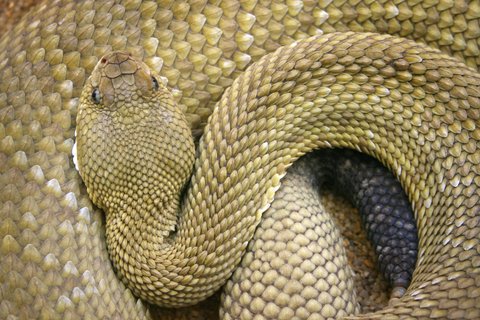
I’ve been exploring the Sierras for 50 years and I’ve never seen a rattlesnake above 5,000 feet. It seems that whenever people ask me about hiking and camping in the Sierras, one of the first questions they ask is “what about rattlesnakes,” at which I reply, “Don’t worry, they don’t live up that high.” Well I was wrong.
According to the California Department of Wildlife, rattlesnakes can live at elevations up to 10,000 feet. Really? And by golly, there are six different types of poisonous snakes in California, all of which are rattlesnakes. Here are a few things to remember if you happen to run into one, or if you happen to get bit.
Identifying a rattlesnake
I got a kick out of a few of these I read. One was to identify the “catlike pupils” or even the common pit between the eyes and nostrils (a common pit viper family trait of which the rattlesnake belongs). Are you kidding me! who wants to get that close? Here’s the deal; treat any two to three foot snake you may encounter as a suspect. Look for the tell-tale diamond shape head and tough-looking skin and the ever-present rattle! Play it safe and slowly move away, giving it plenty of room. I wouldn’t recommend going out of your way to get close enough to positively identify it. It’s a snake for crying out loud! Most people are afraid of snakes.
Avoiding contact
Most encounters are surprises, but there are some practices that will help avoid a close encounter. Look at the trail ahead and all around you. Rattlesnakes love the heat and often cruise around when it’s hot. Awareness is one of the best skills you can have in any situation. Also, people often encounter rattlesnakes when they are climbing around on rocks. I startled many in the Nevada desert over the years while climbing up rocky slopes, and never had a bite. They almost always warn you with a rattle (sometimes it sounds like buzzing) that you will recognize even if you’ve never heard it. They often hide in cool places. Be very careful picking up old pieces of metal or old boards. Watch sticking your hands in bushes. Rattlesnakes hibernate and are the most active when they come out in the spring. They rarely come around campsites, so don’t get too worried about your camp. It’s always a good idea to look for holes and inspect the area around camp. Be aware and you will probably never have to worry.
First Aid
If, by chance, you or one of your party gets bit, stay calm. Although painful and poisonous, rattlesnake bites are almost never fatal. I got bit one time in Death Valley and although it took two hours to get to a hospital, I felt fine the whole time because I did not panic or exert myself. I ended up with a sore, swollen bruise. The more calm you stay, the less chance the venom has to circulate through your body. Keep the bite below the heart (pretty easy considering most bites are on the legs or arms) and NEVER suck the venom out using your mouth like they do on TV. Most fancy snake bite kits are useless. Don’t ice the bite. Chances are good that you’ll be fine if you take it easy and get help.
The bottom line, like all adventures into wild places, is to be aware of your surroundings. Use wide-angle vision and common sense always, and you can usually avoid most hazardous situations.








